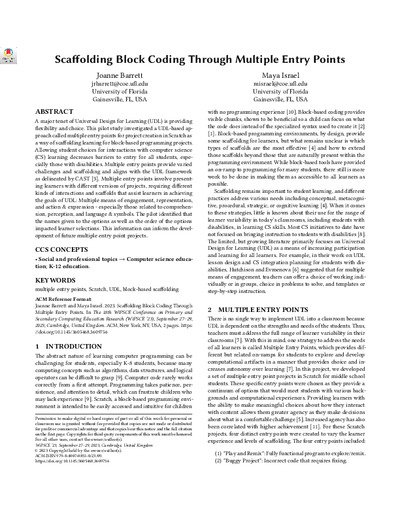Scaffolding Block Coding Through Multiple Entry PointsJoanne Barrett, Maya Israel
Publikationsdatum:
Zu finden in: WIPSCE '23, 2023
|
 |
 Zusammenfassungen
Zusammenfassungen
A major tenet of Universal Design for Learning (UDL) is providing flexibility and choice. This pilot study investigated a UDL-based approach called multiple entry points for project creation in Scratch as a way of scaffolding learning for block-based programming projects. Allowing student choices for interactions with computer science (CS) learning decreases barriers to entry for all students, especially those with disabilities. Multiple entry points provide varied challenges and scaffolding and aligns with the UDL framework as delineated by CAST [3]. Multiple entry points involve presenting learners with different versions of projects, requiring different kinds of interactions and scaffolds that assist learners in achieving the goals of UDL: Multiple means of engagement, representation, and action & expression - especially those related to comprehension, perception, and language & symbols. The pilot identified that the names given to the options as well as the order of the options impacted learner selections. This information can inform the development of future multiple entry point projects.
 Dieses Konferenz-Paper erwähnt ...
Dieses Konferenz-Paper erwähnt ...
 Tagcloud
Tagcloud
 Zitationsgraph
Zitationsgraph
 Zitationsgraph (Beta-Test mit vis.js)
Zitationsgraph (Beta-Test mit vis.js)
 Anderswo finden
Anderswo finden
 Volltext dieses Dokuments
Volltext dieses Dokuments
 |  Scaffolding Block Coding Through Multiple Entry Points: Fulltext at the ACM Digital Library ( Scaffolding Block Coding Through Multiple Entry Points: Fulltext at the ACM Digital Library ( : :  , 413 kByte; , 413 kByte;  : :  ) ) |
 Anderswo suchen
Anderswo suchen 
 Beat und dieses Konferenz-Paper
Beat und dieses Konferenz-Paper
Beat hat Dieses Konferenz-Paper während seiner Zeit am Institut für Medien und Schule (IMS) ins Biblionetz aufgenommen. Beat besitzt kein physisches, aber ein digitales Exemplar. Eine digitale Version ist auf dem Internet verfügbar (s.o.). Es gibt bisher nur wenige Objekte im Biblionetz, die dieses Werk zitieren.









 Lernen
Lernen Programmieren
Programmieren



 Biblionetz-History
Biblionetz-History